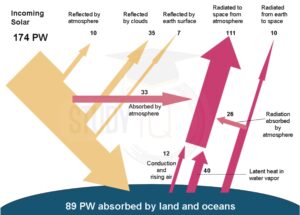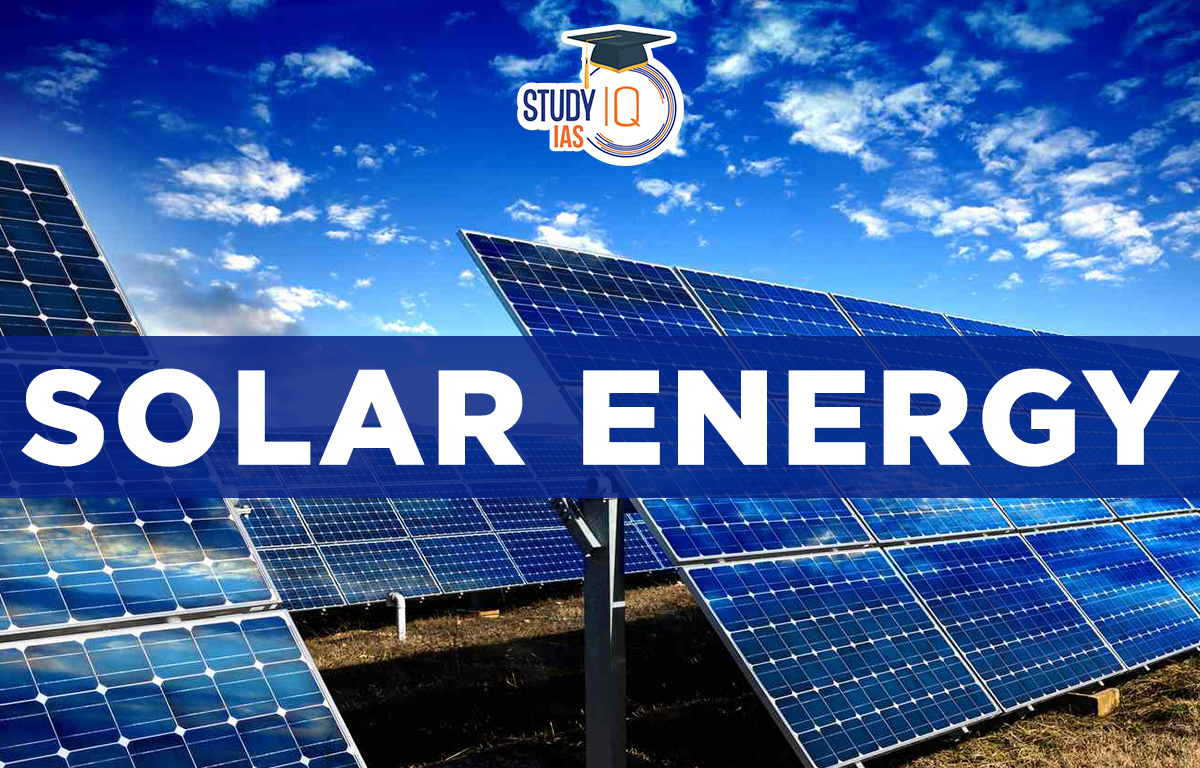Table of Contents
Solar Energy
The energy produced by the Sun in the form of heat and light is known as solar energy. It is one of the most widely available renewable energy sources. It is one of the most important non-conventional energy sources since it is abundant and free. Solar energy can be obtained directly by solar radiation or indirectly through wind, biomass, hydro, and marine sources. People have been using solar energy for a long time. In ancient times, they used magnifying glasses to focus sunlight into beams. These beams were strong enough to start a fire by igniting wood.
Read More: Wind Energy
What is Solar Energy?
Solar Energy is a type of renewable energy that uses the sun’s power to make electricity. It is seen as one of the best sources of clean energy, and more and more people are using it around the world. Right now, we use photovoltaic systems to change sunlight into electricity. These systems have solar panel arrays, which are made up of many solar cells. A normal solar cell creates a voltage of 0.5 to 1 volt and can produce about 0.7 watts of electricity when it gets sunlight.

Read More: Biomass Energy
Solar Energy Potential in India
The country receives around 5000 trillion kWh of energy from the sun each year, with most areas getting 4-7 kWh per square meter every day. India can use solar power very well, and there is a lot of possibilty for growth. The National Institute of Solar Energy says India could produce about 750 GW of solar energy if solar panels covered just 3% of unused land. The best places for solar energy in India are Rajasthan and Gujarat.
Read about: Nuclear Energy
Solar Energy Present Status in India
As of June 2024, India has a total of 148 GW of renewable energy connected to the grid. Out of this solar power makes up 85 GW, wind power is 47 GW, biomass is 1.4 GW, and small hydro power is 5 GW. In the solar power section, 66.5 GW comes from ground-mounted solar panels, while around 13 GW comes from solar panels on rooftops. Hybrid projects and off-grid solar systems add about 2.6 GW and 3.4 GW, respectively.
Since 2014, installed solar capacity has grown from 2.6 GW to 85.5 GW, a 32 times increase. Solar energy is now the cheapest form of energy, but it can vary, so India needs flexible energy sources to better integrate renewable energy, according to Vibhuti Garg from the Institute for Energy Economics and Financial Analysis (IEEFA).
While rooftop solar capacity has also increased, the growth has been slow. India needs to create new financial solutions because the high initial costs are a big problem. In the Union Budget for 2024-25, the government has set aside Rs10000 crore for the Centrally Sponsored Scheme for Solar Power (Grid). This is an increase of 110% from the INR 4757 crore allocated in the 2023-24 budget. The PM-Surya Ghar Muft Bijli Yojana, which started in February 2024 with a budget of INR 75,000 crore, has been given INR 6,250 crore.
Read about: Hydropower Plants in India
Solar Energy Challenges
There are certain challenges of solar energy that need to be overcome
1. Greater Production Costs Per Unit
The price of solar energy has dropped a lot, small solar power projects still cost more than other energy sources. The Union Government is helping to build large solar parks.
2. Basic Obstacles
Getting large pieces of land for big solar parks is hard. There are also problems with losing a lot of energy during transmission, connecting to the power grid, and other issues. Since solar energy is not available at night but there is a high demand for electricity then, balancing the energy load becomes tricky.
3. Environmental Concerns
Building big solar parks has led to disagreements with local people and concerns about protecting wildlife. For example, in Rajasthan and Gujarat, some projects are on hold because the power lines would disturb the home of the critically endangered Great Indian Bustard.
4. Slow Growth
Despite a large increase in installed solar capacity, solar energy’s contribution to the nation’s electricity output has not increased at the same rate. Rooftop solar project capacity increase has been especially poor (less than 20% of objective by October 2022).
5. Financial Restrictions
Because initial investments in solar rooftop projects are typically quite substantial, residential customers and Small and Medium Enterprises (SMEs) must consider their financial capabilities. The lack of creative financing options that offer larger quantities at cheaper interest rates and longer terms is a major problem.
6. Reliance on Imports for Solar Equipment
At the moment, India is unable to make polysilicon or solar wafers. India purchased solar cells and modules worth roughly US$ 76.62 billion from China alone during the fiscal year 2021–22. This made up 78.6% of all imports into India (2021-22).
7. Waste Management
By 2050, it is predicted that India would produce 1.8 million tonnes of solar waste. Solar cell producers are not required to recycle or dispose of garbage from this industry under India’s e-waste regulations.
8. WTO Restrictions
At the World Trade Organization (WTO), India’s Domestic Content Requirement (DCR) rule has been taken to court. The DCR says that solar cells and panels must be made in India and follow the rules and tests set by the Ministry of New and Renewable Energy (MNRE).
Government Initiatives to Boost Harnessing Solar Energy
- As part of the National Action Plan on Climate Change, the Indian government started the Jawaharlal Nehru National Solar Mission in 2010.
- Rooftop Solar Scheme: This program aims to collect solar energy by installing solar panels on the roofs of homes.
- Atal Jyoti Yojana (AJAY): Launched in September 2016, this plan is for installing solar street lights in states where less than half of the homes are connected to the electricity grid, based on the 2011 Census.
- The government is inviting solar panel manufacturers to bid for building solar production facilities with a budget of ₹4,500 crores (about $617 million).
- The National Solar Mission is a major effort by the Indian government and state governments to promote eco-friendly development and improve energy security.
- To help solar project developers set up projects easily, the Production Linked Incentive (PLI) scheme for “Development of Solar Parks and Ultra-Mega Solar Power Projects” was launched in December 2014.
- A program has also been introduced to reach a total capacity of 40,000 MW from grid-connected rooftop solar projects by 2022.
- SRISTI Scheme: This initiative supports the growth of rooftop solar power projects in India.
- International Solar Alliance (ISA): The ISA was formed as a partnership between France and India to work together on using solar energy to fight climate change.
Read about: Nuclear Power Plants in India
Solar Energy UPSC
India has to increase its ability to produce solar energy because it cannot just rely on importing solar technology for large-scale solar deployment. To become competitive and achieve long-term sustainable growth, the full value chain ecosystem must be developed immediately.
Read about: Major Ports in India


 Role of Teachers in Educations, Student ...
Role of Teachers in Educations, Student ...
 India's achievements after 75 years of I...
India's achievements after 75 years of I...
 Bal Gangadhar Tilak Biography, Achieveme...
Bal Gangadhar Tilak Biography, Achieveme...

























